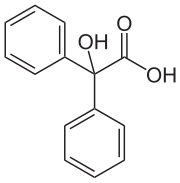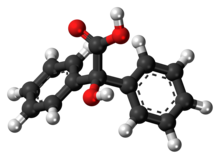Our website is made possible by displaying online advertisements to our visitors.
Please consider supporting us by disabling your ad blocker.
Benzilic acid

| |

| |
| Names | |
|---|---|
| Preferred IUPAC name
Hydroxydi(phenyl)acetic acid[1] | |
| Other names
α,α-Diphenyl-α-hydroxyacetic acid, α,α-Diphenylglycolic acid, α-Hydroxydiphenyl acetic acid, 2,2-Diphenyl-2-hydroxyacetic acid, 2-Hydroxy-2,2-diphenylacetic acid, Diphenyl glycolic acid, Hydroxydiphenyl acetic acid
| |
| Identifiers | |
3D model (JSmol)
|
|
| 521402 | |
| ChEBI | |
| ChEMBL | |
| ChemSpider | |
| ECHA InfoCard | 100.000.904 |
| EC Number |
|
| 281752 | |
PubChem CID
|
|
| UNII | |
CompTox Dashboard (EPA)
|
|
| |
| |
| Properties | |
| C14H12O3 | |
| Molar mass | 228.247 g·mol−1 |
| Appearance | white solid |
| Density | 1.08 g/cm3 |
| Melting point | 150 to 152 °C (302 to 306 °F; 423 to 425 K) |
| Boiling point | 180 °C (356 °F; 453 K) (17.3 hPa) |
| 2 g/L (20 °C) | |
| Hazards | |
| GHS labelling: | |

| |
| Warning | |
| H302 | |
| P264, P270, P301+P312, P330, P501 | |
| NFPA 704 (fire diamond) | |
Except where otherwise noted, data are given for materials in their standard state (at 25 °C [77 °F], 100 kPa).
| |
Benzilic acid is an organic compound with formula C
14H
12O
3 or (C
6H
5)2(HO)C(COOH). It is a white crystalline aromatic acid, soluble in many primary alcohols.
- ^ "Front Matter". Nomenclature of Organic Chemistry : IUPAC Recommendations and Preferred Names 2013 (Blue Book). Cambridge: The Royal Society of Chemistry. 2014. p. 748. doi:10.1039/9781849733069-FP001. ISBN 978-0-85404-182-4.
Previous Page Next Page



